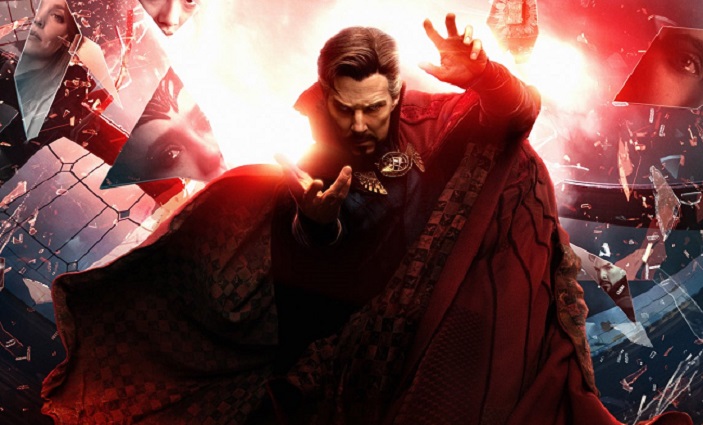Justice for Wanda: Doctor Strange Multiverse of Madness Review
Doctor Stephen Strange wakes from a vivid dream about himself running alongside a young girl as they try to stop an enormous, tentacled monster. Soon he discovers that it was no dream. At least, not in the way we think of them. It turns out, dreams are windows into the lives of our multiversal selves. The girl is real. Her name is America Chavez and she has the ability to move between universes. Her power is coveted by an unknown villain. Her powers in the wrong hands could be catastrophic, which is why Strange and the rest of the Masters of the Mystic Arts at Kamar-Taj immediately set out to protect her.
The immediate gut reaction to the movie is that it was fun and significantly more gory than your standard Marvel movie. As we have come to expect from Doctor Strange movies, the special effects were particularly impressive. (The music note battle scene in particular stands out to me, though it is by no means the only moment that stood out.) There was also a lot of nods to the TV series, which are largely superfluous when it comes to understanding the movie and feel largely like Easter eggs rather than crucial precursors to the film. What If does introduce you to a handful of alternate universe characters that cameo in the movie, but you don’t need the episodes to understand anything. Despite Loki dealing with aspects of the multiverse, you don’t need it either. The only series that feels strongly connected is, of course, WandaVision. Which is what makes director Sam Raimi’s comments during a Rolling Stones interview particularly flabbergasting:
I never even saw all of WandaVision; I’ve just seen key moments of some episodes that I was told directly impact our storyline.
The fact is, it shows.
(SPOILERS AHEAD)
In WandaVision, Wanda attempts to coming to grips with the traumatic loss of Vision by altering reality to give herself the dream life – Vision, alive and her husband, along with twin sons, Billy and Tommy. She spends the series discovering the origins of her powers (it turns out the tesseract experiments only amplified her natural magical abilities – she is the preternaturally powerful Scarlet Witch) and realizing that she must let go of this false reality because it is hurting innocent people. Reluctantly, she ends the spell, losing her husband and sons in the process. After learning this important lesson and making this difficult sacrifice, she goes off to live by herself in the wilderness and studies the Darkhold, a dangerous book of dark magic that corrupts anyone who uses it.
The corruption, it is implied in this movie, is that it leads her to believe that she can reunite with her children, who apparently exist in other alternate universes, no matter the cost. The cost, is the life of America Chavez, whose power she wants to steal in order to not only reunite with them but also be able to universe hop in order to resolve any problems that may arise in their lives. (One of her justifications for taking America’s life: “She’s not a child, she’s a supernatural being.”) This might have made sense, if she hadn’t already learned this very lesson – that she can’t make others suffer in order to have her family. Why she can’t use her magic to simply recreate her boys as she did the first time (without imprisoning an entire town of people) is unclear. What is clear is that this movie did Wanda dirty and retread ground that we had already dealt with in the show.
If the show had never happened, her turn to the dark side might have made sense. As she points out, she is held to an unfair standard. When she breaks the rules, she is vilified, when Doctor Strange breaks the rules, he is a hero. (Not quite as true after this movie, but mostly true.) When an attempted mission went wrong in The Avengers: Age of Ultron she is treated as if she is dangerous, rather than anyone realizing that what happened was not only an accident but was also a result of the team as a whole running out of time. She “blew a hole through the head of the man [she] love[d] and it meant nothing” in Avengers: Infinity Wars and unlike most other people, her loved one never came back. To then be forced to give up her children and then dream about them every night…Her motivation is easy to understand, it simply didn’t add up with the end of the series.
Stray thoughts:
- Do we get a show where America searches for her long-lost family? I’d watch that.
- America is yet another member of the Young Avengers that the Marvel Cinematic Universe seems to be building.
- I don’t know about anyone else but I’d like to know more about the universe where everyone is made up of paint.
- We got an introduction to the X-men and Fantastic Four.
- America smashes a window ledge early in the movie but then seems surprised by her strength later in the movie.
- Why was Wanda limping on glass-cut feet when she can just fly?
- Where did all the new students at Kamar-Taj come from?
- Does Doctor Strange have the dexterity to do that watch repair all on his own?
ABOUT THE MOVIE
Official Synopsis: Marvel Studios’ “Doctor Strange in the Multiverse of Madness”—a thrilling ride through the Multiverse with Doctor Strange, his trusted friend Wong and Wanda Maximoff, aka Scarlet Witch.
Rated: PG-13
Starring: Benedict Cumberbatch, Elizabeth Olsen, Benedict Wong, Rachel McAdams, Chiwetel Ejiofor, and Xochitl Gomez
Directed By: Sam Raimi
Screenplay by: Michael Waldron
Produced By: Kevin Feige
In Theaters: May 6, 2022
Runtime: 2 hrs 6 min
Watch the trailer:
Photo: Doctor Strange in the Multiverse of Madness. Courtesy of Marvel Entertainment.

